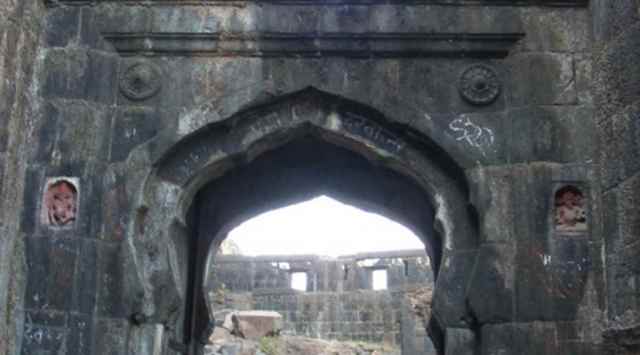 Ganesha Darwaja at Lohagad.
Ganesha Darwaja at Lohagad.
According to researchers, the word ‘Ganpati’ literally translates into protector of the clan (‘gana’ means clan and ‘pati’ means leader/protector) and the deity is often hailed as the warrior hero.
In Hindu mythology, Lord Ganesh is widely regarded as a god of wisdom and a remover of obstacles. But the benevolent deity is also known to play another role for his devotees: that of the playful protector.
It is in this role that images of Ganesh appear on the stone gates of the forts located along the hilly areas of the Western Ghats.
While trekking in Sahyadri hills around Pune, one might come across the Ganesh (Ganpati) idol chiselled in stone gateways to forts as ‘dwar rakshak devata’ (gate-guarding deity). This can be found in many forts in the Pune district like Korigad, Dhavalgad, Purandar.
According to Dr Sachin Joshi, who is a researcher with Deccan College Post-Graduate and Research Institute in Pune, different gods and goddesses are present as designated protectors according to cultural traditions and popularity of deities in specific regions.
“Some forts have a Shiv Ling. Sinhagad has a Narsimha temple, and also village deities like the goddesses Vinjai, Janai and Megai can be seen on forts in Pune district. The customs may change in the coastal Konkan strip of Western Maharashtra where Bhairava, is also worshipped in the fort temples. But only Ganpati and Hanuman have been venerated as dwar rakshak,” he says.
Dr Joshi says the first written references to Ganeshotsav in Maharashtra as known today are found in the literature produced in the Peshwa period around the 13th century. It was limited to individual households then and not extended towards the community as a whole.
However, forts around Pune dotting the Sahyadris with their own temples have a history of their own, he says.
Ganpati and Hanuman are seen as standing vigil in the form of ‘dwar rakshak’ at these massive fortresses.
“You may have observed a small Ganpati sticker or idol above doors to houses. It’s the same logic because they are the guardians and that is why they were placed above the entrances to these forts,” he says.
Interestingly the word ‘Ganpati’ literally translates into protector of the clan (gana-clan, pati-leader/protector) and Ganpati is often hailed as the warrior hero.
The fortifications and settlements on Sahyadris were built during the rule of Shivaji Maharaj in the 13th-14th century, according to Joshi. Marathas were followers of the Hindu religion and so this religious symbolism is observed on forts built in this period, he says.
Interestingly, entries on texts found detailing the expenses on the Purandeshwar fort also show a specific amount allotted for the maintenance of these temples. “But temples were never a centre of power as observed with relation to temple estates in the South, like Tamil Nadu, due to the unstable power dynamics in the region,” Joshi says.
Historians are also uncertain about the religious hymns sung then or religious customs they adhered to, Joshi says. ”The modern-day ‘aartis'(prayers) are also traced back to the Peshwa period and we have no clue yet regarding the hymns sung during the period before the Lord as much of it has been passed orally,” he mentions. - indianexpress
No comments:
Post a Comment